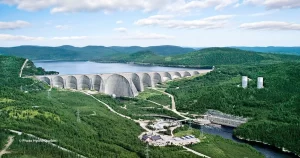
The Champlain Hudson Power Express (CHPE), a high-voltage direct current (HVDC) line, will deliver 1,250 megawatts of clean electricity from Canada’s Hydro-Québec, the fourth-largest hydropower producer in the world, to New York City.
HVDC energy transmission transmits power over long distances more efficiently than alternating current (AC) transmission.
The CHPE, which is permitted and expected to be fully operational in spring 2026, will be completely buried. It will transmit electricity for more than 372 miles (600 km).
It will run from the Hertel substation in La Prairie, Canada, to an interconnection point in the Richelieu River. It will then run through Lake Champlain and the Hudson River to an HVDC converter station in Astoria, Queens, where it will be connected into the Con Edison grid.
The project will utilize waterways, existing roads, and railroad rights of way. The cables will be monitored on a continuous basis. Unless damage is detected, they will be virtually maintenance-free.
Yesterday, the CHPE announced that it has finalized contracts with three companies to oversee major construction operations:
- Cable supplier NKT will complete the design, manufacturing, and submarine installation of the project’s two 5-inch diameter 400kV high voltage direct current (HVDC) cables.
- Hitachi Energy will design, deliver, and test the technology for the converter station at the Astoria Generating Complex in Queens. It will also will supply the HVDC light converter station that will convert the DC power from Canada to AC power and make it available for the AC grid in New York.
- Construction company Kiewit will lead the on-land construction activity for the entire HVDC route including the converter station in Astoria.
The CHPE is expected to decrease emissions by an average of 3.9 million metric tons per year. That’s the equivalent of removing 44% of passenger vehicles from New York City.
New York State’s new Climate Leadership and Community Protection Act (CLCPA) requires that the state be powered by 70% renewable energy by 2030.
